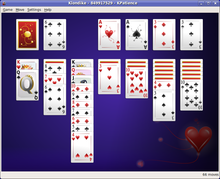Solitaire
| Look up solitaire in Wiktionary, the free dictionary. |


Solitaire is any tabletop game which one can play by oneself, usually with cards, but also with dominoes. The term "solitaire" is also used for single-player games of concentration and skill using a set layout tiles, pegs or stones. These games include peg solitaire and mahjong solitaire. The game is most often played by one person, but can incorporate others.
History[]
The origins of Card Solitaire or Patience are unclear, but the earliest records appear in the late 1700s across northern Europe and Scandinavia.[1] The term Patiencespiel appears in Das neue Königliche L’Hombre-Spiel, a German book published in 1788.[2] Books were also reported to appear in Sweden and Russia in the early 1800s. There are additional references to Patience in French literature.[3] In the United States, the first card solitaire book, Patience: A series of thirty games with cards, was published by Ednah Cheney in 1870.[4]
The card game that many people identify with Solitaire is Klondike Solitaire, which is the most played solitaire game.[5] Although it was originally played with a physical deck of cards, it was especially popularized by Microsoft Solitaire, a digital implementation that was included with the Windows operating system from 1990 onwards.
Forks of PySol are platform-independent, open-source implementations of hundreds of solitaire games.[6] Many other software implementations of solitaire exist, and it is still frequently played on computers, mobile devices, and online as a recreational game.
Types of solitaire games[]
- Patience or card solitaire, also known as "solitaire with cards", generally involves placing cards in a layout, and sorting them according to specific rules.[7] The most common solitaire card game is Klondike. Other popular variations include Spider, Yukon, and FreeCell.
- Mahjong solitaire is a single-player matching game that uses a set of mahjong tiles rather than playing cards. It is more commonly played on a computer, than as a physical tabletop game.
- Peg solitaire is a board game where the goal is to empty the board of pegs through movement and capturing. It is more of a puzzle than a game, since it is repeatable once it is solved.
- Concentration also known as Memory, Pelmanism, Shinkei-suijaku, Pexeso or simply Pairs, is a card game in which all of the cards are laid face down on a surface and two cards are flipped face up over each turn. The object of the game is to turn over pairs of matching cards.
See also[]
| Wikimedia Commons has media related to Solitaire. |
References[]
| Wikibooks has a book on the topic of: Solitaire card games |
- ^ Parlett, David (1979). The Penguin Book of Patience, Penguin, London, p. 15. ISBN 0-7139-1193-X
- ^ "History of Solitaire" in Roya, Will (2021). Card Night: Classic Games, Classic Decks, and the History Behind Them. Black Dog & Leventhal Publishers. p. 47. ISBN 9780762473519.
- ^ Morehead, Albert (May 6, 2015). The Complete Book of Solitaire and Patience Games. Read Books Ltd. ISBN 9781473395381. Retrieved August 6, 2020.
{{cite book}}: CS1 maint: date and year (link) - ^ "History of Solitaire". Solitaired.
- ^ "The Three Most Played Solitaire Card Games in the World". 23 June 2020.
- ^ Harac, Ian (2009-03-27). "PySol FC Gives You All the Free Solitaire Imaginable". PCWorld. Retrieved 2020-10-09.
- ^ Yan, X., Diaconis, P., Rusmevichientong, P., & Roy, B. V. (2005). Solitaire: Man versus machine. In Advances in Neural Information Processing Systems (pp. 1553-1560).
External links[]
- David Parlett. Historic Card Games: Patience playing-card solitaires
- Single-player games
- Solitaire tabletop games
- Card games
